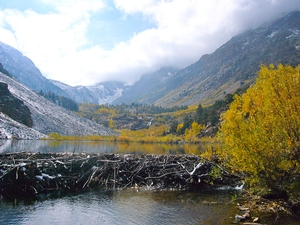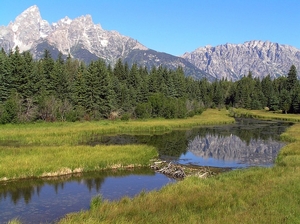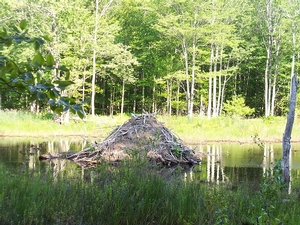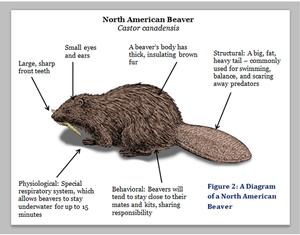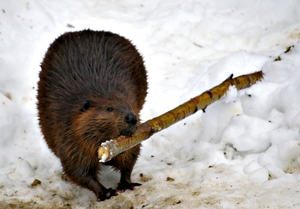The North American beaver (Castor Canadensis) is the largest rodent in the Adirondack Park, and is the New York State mammal. Its preferred home is a burrow in one of the Adirondack's many riverbanks. Beaver dams are common throughout the Adirondacks as well. Dams create wetlands by pooling moving water, where the beaver than builds its home. Beaver families reside in spacious dome-like structures called lodges that are usually found in the middle of ponds. Lodges house monogamous parents and their young kits or last spring's babies. Beaver dams and lodges are made primarily of timber and mud; they often raise the level of the water and surrounding water table by many feet. Each beaver family defends about half a mile of territory around their dams because as herbivores, the family requires a large range of diverse plants to feed on. The beaver's territory is defended by means of scent mounding. And they defend their territory by violently fighting off other beavers, but rarely killing the other.
Beavers are known as a keystone species* because their manipulation of the environment provides a space for diverse ecology. Beavers selectively cut trees that are essential for building dams and lodges, leaving room for new species of plant and tree to grow in the place of older trees. The new plant species attract animals such as deer and others that feed on new growth.
Those who study the beaver call it "nature's finest wetland engineer" (DEC.NY.GOV, "What is Beaver). They are known to impact the waterways that they inhabit in both positive and negative ways. Colonization of waterways provides a unique habitat for furbearer and waterflow species. However, animals that thrive in cooler water, such as reptiles and some fish species, are often forced out of the environment that beavers inhabit, since beaver dams and lodges raise the temperature of the water several degrees.
Beavers can thrive in the Adirondacks because they are active through the winter, swimming under the layers of ice and keeping warm in their well-insulated homes. To learn more about the habits of the beaver in the winter click HERE. Beavers can stay under water for 15 minutes and they are able to see under water using a set of transparent eyelids that act as goggles. Their webbed feet and paddle tails allow them to swim quickly and make sharp turns in the water.
Beaver tails have a layer of compressed aggregated hairs under the scaly tissue that provides them with a tool to regulate their temperature. Their tails also serve as a fat storing tool to reserve calories and provide warmth in winter months and, when hit against the water, are used for communication between other members of the colony.
Beavers feed on cellulose, which can be found in wood-like plant material. Beavers possess special microorganisms that digest wood materials that allow them to maintain their diet. They eat the leaves, bark, and twigs of aspen, red maple, and willow trees. Additionally, beavers eat a variety of plants and, in summer months, aquatic plants such as water lilies, rhizomes, and shoreline ferns. Beavers also store food for the winter months in underwater caches near the lodge called a raft or feed pile.
Although the beaver is prey to animals such as the fisher, coyote, bear, and bobcat, its most successful predators are humans. Beavers fall prey to trappers and automobiles more frequently than any other deadly force, as according to the DEC's article titled Beaver. Kits fall prey to mink, otter, fox, and great-horned owls. Beavers also suffer from internal and external parasitic infestations. Parasites that are commonly found in beavers include the roundworm, Giardia Lambdia (two-celled flagellate), and various mites.
*For more about keystone species click HERE
Sources: "Beaver." Dec.NY.Gov. ; "Amazing Facts About Beavers." OneKind.org. ; "About Beavers." Beaversww.org. ; "Beaver Castor Canadensis." National Geographic. ; Rosell, Brozsér, Collen, Parker. "Ecological Impact of Beavers Castor Fiber and Castor Canadensis and Their Ability to Modify Ecosystems."
Images: Creative Commons
